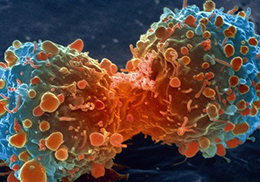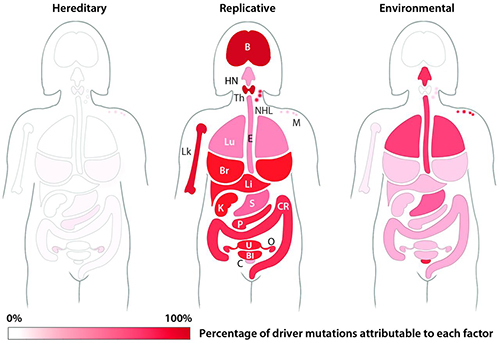
Cancers are caused by mutations that may be inherited, induced by environmental factors, or result from DNA replication errors.
A new study suggests that two thirds of the cancer cases are caused by errors in the replication process, accentuating the importance of early detection and intervention to reduce deaths from the many cancers arising from unavoidable DNA replication errors.
6 april 2017
Cancers are caused by mutations that may be inherited, induced by environmental factors, or result from DNA replication errors. A new study (Tomasetti, Li and Volgestein, 2017) suggests that two thirds of the cancer cases are caused by errors in the replication process, accentuating the importance of early detection and intervention to reduce deaths from the many cancers arising from unavoidable DNA replication errors.
It is now widely accepted that cancer is the result of the gradual accumulation of driver gene mutations that successively increase cell proliferation. There are two factors that have been widely researched in this regard:
- Environmental factors.
- Hereditary factors.
These factors have been validated through multiple studies and a strong amount of evidence has been collected to confirm them, both through family and epidemiological studies.
Nevertheless, it has been hypothesised in a new study about the possibility of a third source of mutations that could explain why cancers are much more common in some tissues than in others: Mutations due to the random mistakes made during normal DNA replication.
A third source of mutations could explain why cancers are much more common in some tissues than in others: Mutations due to the random mistakes made during normal DNA replication.”
This hypothesis was based on the observation that the lifetime risks of cancer among 25 different tissues were strongly correlated with the total number of divisions of the normal stem cells in them. This observation has generated an intense scientific debate about the relative weight of each of the three factors in the risk of developing cancer, especially considering the diversity of cases that can be found.
The study has evaluated the incidence of cancer in 69 countries and in all the examined countries it was found a strong statistically significant correlation between the risk of cancer and the number of divisions of stem cells of each tissue.
These data, taking into account the large differences in environmental factors between the studied countries, raises a question: What fraction of cancer-causing genetic mutations come from each factor? (Environmental, Hereditary and Replication errors)
Two thirds of the cancer cases could be caused by random errors in the replication process.”
Following a rigorous analysis of the data, and according to estimates of institutions such as Cancer Research UK or U.S. Centers for Disease Control and Prevention, evidence suggests that about 2/3 of cancer cases could be due to random errors that occurred in the normal replication process linked to the division of stem cells throughout life.

These results do not contradict the current emphasis on cancer prevention by environmental factors, since the importance of prevention based on these factors is enormous. However, they add a field of research and prevention that must increase its relevance even more: early detection and intervention. For cancers derived from mutations due to replication errors, this prevention is currently the only option.
Tomasetti, C., Li, L. and Vogelstein, B. (2017). Stem cell divisions, somatic mutations, cancer etiology, and cancer prevention.










